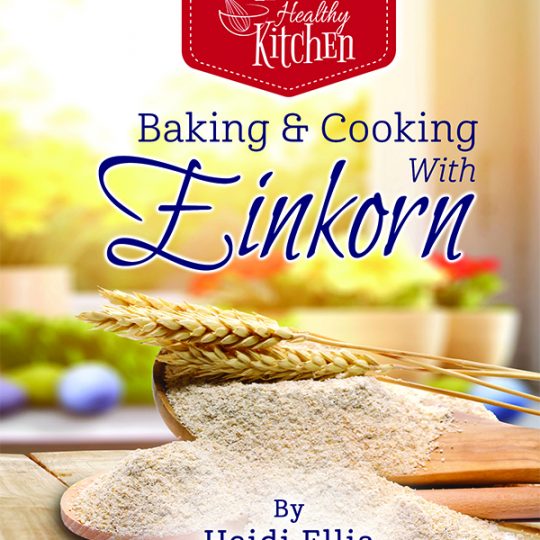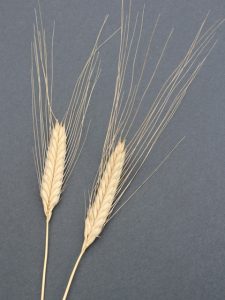
Einkorn
What is Einkorn?
Einkorn (Triticum monococcum) is the most primitive and oldest known wheat. It is considered man’s first wheat. Einkorn can be traced back thousands of years. The first record of einkorn being domesticated was around 7500 B.C. It is believed to have originated in the regions of the Tigris-Euphrates, known as the Fertile Crescent. The evidence suggests einkorn was domesticated in what is now Turkey.
The term einkorn comes from the German language. Its interpretation means “single grain” or “one kernel”. Einkorn gets its name from the single kernel, or husks, on the head of the grain plant containing one kernel each.
Einkorn spread to many other countries and has names in various languages as a result. Here are some examples:
-
Einkorn – German
-
Small spelt – Italian
-
Farro piccolo – Italian
-
L’engrain – French
-
Le petit épeautre – French
-
Tiphe – Greek
-
Siyez – Turkish
-
Sifon – Hebrew

Why Is Einkorn Different from Modern Wheat?
Einkorn is much different from modern forms of wheat in some very stark ways.
For starters, the grains themselves are much smaller than modern wheat. There is also a crease on the side of modern wheat kernels that is not present in einkorn. Each grain is wrapped tightly in its own husk, making it a hulled wheat. The hull makes it more difficult to harvest, but because the grain is tightly wrapped, it’s more difficult for bugs and stray chemical contamination to get in. The way einkorn grows actually makes it easier to grow organically. Yay for us!

The reason why einkorn is so different from modern wheat is because it has not been altered in any way. Humans have steadily altered the genetics of modern wheat by crossing them with other plants. Now they’re also altered with chemicals so that they can choose the seeds that have higher gluten and higher yields. With the advent of chemical pesticides, they also choose seeds that are more bug resistant.
As result of the altered genetics of modern wheat, the gluten in modern wheat is completely different from einkorn. Einkorn has only the A genome present in its genetic makeup. Modern wheat has been crossed with other plants with other genomes, and as such, has more than the A genome. Modern wheat contains a D genome. This D genome is not present in einkorn. The D genome is the main contributor to gluten sensitivities. Current testing for gluten content is based on the D genome. There have been some who say that einkorn is gluten-free. This is most likely because of the test for the D genome, which is absent in einkorn. Einkorn does have gluten, it’s just totally different. It’s an unaltered form of gluten; the way wheat was meant to be.
Einkorn is a diploid, like many other plants. This means it has two sets of chromosomes. Modern wheat and some other grains have 6 sets of chromosomes. Einkorn has only14 chromosomes total, and modern wheat has 42 chromosomes. Einkorn’s simpler genetic makeup clearly make it the purest and most ancient form of wheat.
This simple genetic makeup also makes it easier to digest! It’s easier for the body to absorb nutrients when you have good digestion. Einkorn supports healthy digestion, making it much healthier to eat than modern wheat.
Here’s a great video about the genetic makeup!
Einkorn Is a Nutritional Powerhouse!
Compared to many other grains, and particularly modern wheat, einkorn is far superior in nutrition. There’s a reason it has been referred to as the staff of life for thousands of years.
It is higher in protein and so many other vitamins and minerals! Check out this list of some of its amazing nutritional benefits:
-
Higher levels of protein than modern wheat
-
Has unaltered gluten
-
Has essential fatty acids
-
Has more phosphorus than modern wheat
-
High in potassium
-
High in vitamin B-6
-
3-4 times more lutein and beta-carotene than modern wheat
-
Has loads of antioxidants
-
2x the amount of vitamin A than modern wheat
-
4-5x more riboflavin than modern wheat
-
More thiamin (B-1)
-
Higher in zinc
-
Much higher in manganese
-
Higher in iron
Einkorn also tastes amazing! It has really great flavor. It’s my opinion that all the nutrition is what makes it taste so amazing.
There’s a great article by Einkorn.com that compares the nutrient content of einkorn to many other grains. I highly recommend checking it out. Here’s the link:
https://www.einkorn.com/types-of-wheat-nutritional-content-health-benefits-comparison/
Why Is Einkorn Easier to Digest?
Many people who eat modern wheat find that they have bloating and congestion, among other issues. With einkorn, a majority of the people who use it find that they don’t have any other of those issues. Now, if you have Celiac Disease, that’s a different story. However, there are many people who have gluten sensitives, or even intolerance to modern wheat, who eat einkorn. Just do a google search and you’ll see!
There have been some suggestions as to why einkorn is easier to digest: one being the protein (gluten) composition of einkorn as was discussed earlier, two being the starch structure of einkorn, and three being that there are higher amounts of water soluble proteins in einkorn.
There have been some studies done by researchers studying ancient grains. According to them, the starch structure of einkorn, and how it’s digested by the body, creates lower levels of glucose and insulin levels in the blood after eating. It also makes you feel full longer. This is huge! It’s bread that is low glycemic, that you don’t have to eat a ton of!
It was also interesting to me that the study noted naturally leavened bread (sourdough) was by far the best on digestion and on the insulin response after eating.
To read more about this and about the soluble proteins, check out this great article. All the sources are sited in the article. It’s fantastic!
https://www.einkorn.com/3-reasons-einkorn-may-be-easier-to-digest-than-other-types-of-wheat/
Tips on Using Einkorn
Just a few short tips on using einkorn:
- I would highly suggest grinding your own einkorn berries. Fresh flour is amazing, and it keeps the nutrition longer than buying flour that has sat around. Every type of flour loses nutrition over time after being ground.
There are lots of great grinders out there. They basically fall into 3 different categories: ceramic stone grinders, steel burr grinders, and high-speed impact grinders.
I have a high-speed impact grinder. I love it! It is loud, but it grinds quickly and the flour is very fine. It doesn’t have a great variety of coarseness options though. I have been in the market for a grinder that has more options, so I can do things liked cracked cereal. I think it’s also great to have one that doesn’t rely on electricity. Then you can have flour even if there are outages. I’ll let you know when I get one, and let you know how I like it.
There is a great article that lists the pros and cons of the different kinds of grinders. You can choose which is best for you. There are different brands with different pricing. You’ll just need to do a bit of research. Here’s the link.
https://www.einkorn.com/grinding-einkorn/
- Einkorn needs less water. When you are looking at a recipe, you just need to evaluate what else is in the recipe that is a liquid. Butter and eggs don’t count, but liquid oil does. It is also my experience that maple syrup and honey can affect liquid content too.
If your recipe just calls for one type of liquid, I would reduce the liquid by ¼. If the recipe calls for oils, lemon juice, or some other type of liquid, I would reduce it by ⅓.
- Einkorn needs to be worked less. We have become so used to working with breads and baked goods made with modern flour, particularly white flour. They have a super highly altered gluten content that requires working it that much.
However, because the genetic structure of einkorn is so different from modern wheat, it has less chromosomes, so it does not need to be worked very much. The more you work it, the faster the gluten will break down and will fall apart. The first time I made bread with einkorn, I used my go-to recipe that I had been using for years. It has you mix the bread dough in the mixer for 10 minutes. I was using whole white wheat back then. I did the same thing with the einkorn. It totally destroyed the gluten. It literally fell apart. It became a kind of liquid that I poured into the bread pan. Now, I mix einkorn bread for 2-5 minutes total. It makes bread making a lot faster and less time consuming for sure.
If you have other questions about working with einkorn, feel free to contact me, or shoot me a message over Facebook Messenger
Other Articles
When I first started learning about einkorn, I ended up on Einkorn.com. They have amazing articles about einkorn. They do lots of research and support research studies about einkorn. Here are a few of my favorite articles:
Healthy Grains: 25 Reasons Einkorn Tops the List
https://www.einkorn.com/healthy-grains/
Did Wheat Hybridization Give Rise to Celiac Disease?
https://www.einkorn.com/did-wheat-hybridization-lead-to-celiac-disease/
What’s Lacking?
https://www.einkorn.com/whats-lacking/
Antioxidants in Einkorn Better preserved in the Baking Process
https://www.einkorn.com/antioxidants-in-einkorn-better-preserved-in-baking-process/
Lack of Toxicity in Einkorn Gliadin
https://www.einkorn.com/toxicity-of-einkorn-gluten/
Check Out My Book!
Writing my cookbook about einkorn was a total adventure. I learned SO much more about einkorn and how to work with it, and I even learned more about the science of baking than I ever thought I would. My book is like a part of me. My heart and soul went into it. I hope that you feel that when you use it.
I want everyone to be successful with einkorn, so they can add it to their healthy lifestyle.
One of the things that I love about my cookbook is that it isn’t just about einkorn. It’s about a healthy lifestyle. I wrote it the way my family eats. Every recipe is made with healthy oils and healthier sugars that don’t spike the pancreas, like refined sugar does. I use heavy metal free baking powder and organic dairy, or dairy substitutes. Everything about my cookbook is about living a healthier lifestyle. I am so excited to share that lifestyle with all of you!
Check out my book here.
-
 $29.95 – $215.60
$29.95 – $215.60
If you have questions, please feel free so contact me.
